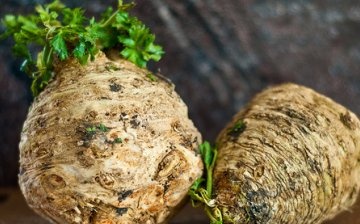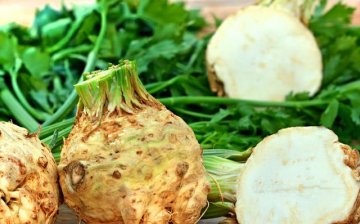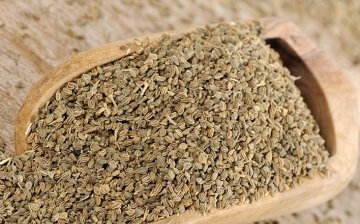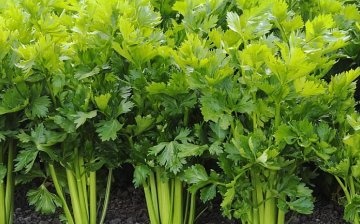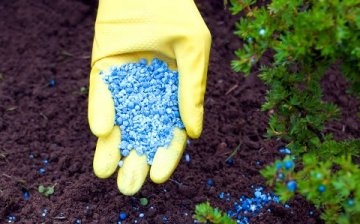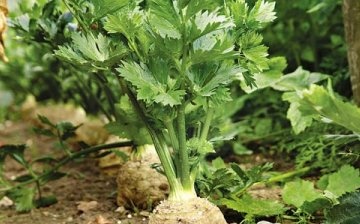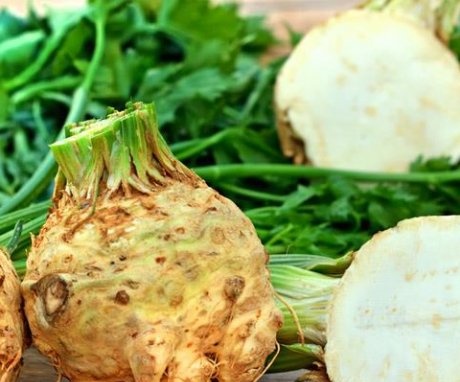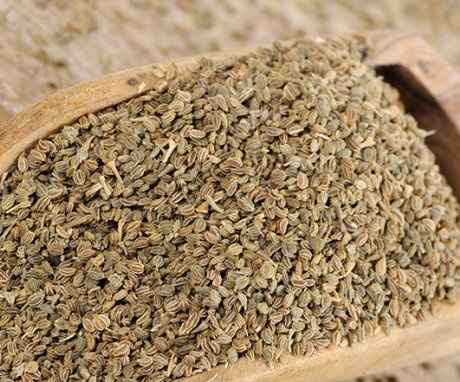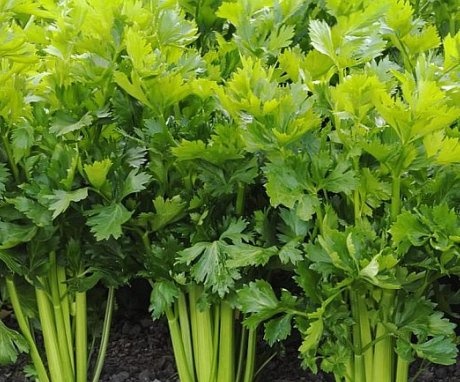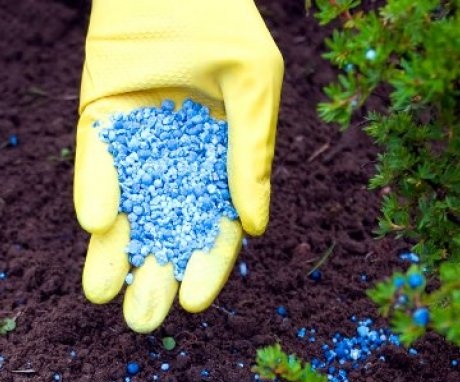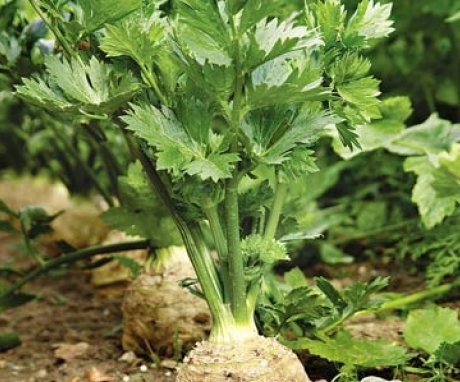Recommendations for gardeners: how to grow root celery from seeds
Celery is a fairly valuable spice plant. Thanks to the essential amino acids, essential oils and amino acids that make up it, it has beneficial properties. Therefore, it is a pleasure to grow celery on your site. We will talk about the features of growing celery root in this article.
Content
- Features of celery and recommendations for choosing seeds
- Seed sowing rules and care
- Planting seedlings in the ground
- Root celery care rules
- Diseases and prevention of cultivated plants
Features of celery and recommendations for choosing seeds
Among the most important functions celery - it slows down the aging process, improves the functionality of the liver and kidney function, and has a beneficial effect on the nervous system. All parts of the cultivated plant are used. Its leaves are used as spicy herbs, and the root is a very valuable and dietary product. A large number of not only tasty, but also healthy dishes can be prepared from it.
Growing root celery from seed has its own characteristics. The fact is that such a vegetable should be grown seedlingsthat sprouted from seeds. A cultivated plant is planted by the beginning of spring - the beginning of March is its extreme point.
The best time for sowing is mid-February, and even better at the very beginning of the last month of winter.
Of course, who has not seen celery root. It can often be seen either on store shelves or in the market. But still, it is necessary to dwell on some of the features of this healthy vegetable. First of all, it should be noted that this cultivated plant belongs to plants from the Umbrella or Celery family. In total, there are more than 20 types of celery that grow in the wild. The most famous species is the aromatic celery, which we eat.
Celery is a biennial plant. In order to get greens and roots for consumption, it is necessary to grow it for exactly one year. The next year, the cultivated plant begins to bloom and form fruits with seeds, which are necessary for a new sowing and growing new vegetables.
The appearance of celery resembles a common herb. It has simple leaves with feathery dissections. During the flowering period, its flowers resemble umbrellas of a simple or complex type, which are collected in small inflorescences. After flowering comes to an end, a seed-fruit appears. The root of a cultivated plant is tap root. It forms the root vegetable that we are used to eating.
The vegetable is capable of propagating by seeds.
But it is worth considering the fact that they germinate for a long time. But they make good harvest, which is getting better every year. It is recommended to use those seeds that have already been laid for three years. Their seedlings are much better than those harvested a year or two ago. When choosing planting material, several factors must be taken into account, namely:
- Features of the climate in which the vegetable will be grown.
- Ripening period for celery.
- Ripe fruit size.
Also note that the yield depends entirely on the seeds. Therefore, it is necessary to take into account several important recommendations for their selection:
- Buy only fresh and high quality the seeds.
- Choose celery seeds, the fruits of which, when ripe, will have a mass of at least half a kilogram.
- Give preference only to early maturing varieties so that the planting itself and the ripening period can provide full-fledged fruits as a result.
- It is best to buy seeds from foreign producers. As a rule, their planting material is of better quality.
Thus, taking into account all the recommendations, you will get a wonderful harvest of this incredibly healthy, spicy vegetable.
Seed sowing rules and care
In order to grow root celery using seeds, you must first sow them and wait until the seedlings begin to germinate. It is best to start planting a cultivated plant using the seedling method in February. Why exactly during the last month of winter? It's very simple - the growing process of celery is very long. Its duration can range from four months to six months.
The next step in growing celery root from seed is the selection of the vessel and the preparation of the substrate.
- The most important factor in choosing a vessel is that at the moment transplants seedlings in open ground, it could be easily removed from the container without damaging root system.
- It is necessary to fill it with soil, consisting of sod land and the same amount of humus.
- To keep the soil loose, you can add a handful of sand.
- A few days before sowing seeds, you need to disinfect the soil - it will be enough to pour it with hot water with potassium permanganate additives.
To ensure the best germination of seeds, it is recommended to soak them in a gauze bag before planting. First, you need to hold it under a stream of boiling water for several minutes, and then place it in warm water for three days.
Sowing seeds is done in moist soil.
You need to make small grooves in it and plant the seeds between them at a distance of 5 centimeters. They are not sprinkled with earth on top. I cover the vessel with foil or glass in order to create a greenhouse effect. From time to time it is necessary to moisten the ground with a spray bottle. If necessary, provide additional light sources - for example, an ordinary lamp. As soon as the first leaves appear, you can carry out pick.
Thus, the process of sowing seeds is not that complicated. The main thing is to provide them with constant moisture and a light source. After 2-3 months, the seedlings can be safely transplanted into open ground.
Planting seedlings in the ground
The emergence seedlings allows you to plant it in open ground. This can be done in mid-May. Please note that the soil must be loose and fertile. Therefore, if you decide to grow celery, then you need to take care of the soil in advance, even in the fall. Planting of seedlings of cultivated plants is carried out only when warm and sunny weather sets in.
The sprouts must be planted at a distance of 30 centimeters so that future roots do not get crowded and do not deform under the pressure of each other.
Do not make the holes too deep and do not try to deepen the seedlings themselves. It is recommended to cover the beds where celery is planned to be planted until June with a special material that keeps heat well.
After planting seedlings in the ground, make sure that they have enough moisture. Do not remove the special material before the allotted time and your sprouts will become strong and healthy.
Root celery care rules
Care for root celery is not much different from caring for other cultivated plants. It includes:
- Implementation of regular glaze.
- Loosening the soil between the rows where the seedlings are planted.
- Getting rid of weeds and weeds.
- Top dressing must be high in potassium and minerals. You can take chicken manure for this and mullein... In total, you need to do three dressings - the first immediately after planting in the ground, the second and third - during the period of rapid growth of celery and its root.
- Preventive action against fungal infections (early August).
- Also, to get a beautiful, round and tasty fruit - you need it in the middle of the summer season prune roots that grow on the sides of the root crop. To do this, they rake off the earth and after the places dry out with a cut, the celery is spud.
Diseases and prevention of cultivated plants
To exclude any development of celery root disease, you need to adhere to some rules:
- Change the planting site of the vegetable every year.
- Do not plant celery in the ground where sick plants germinated earlier.
- Planting seedlings, alternate queen cells of the first and second years.
Among the main pests are:
- White rot. It is capable of affecting all parts of the plant - from the root to the top of the leaves. It manifests itself in the form of a white bloom, which turns black over time. It promotes the decay of the vegetable. Having found it, you need to spray the celery with copper sulfate, which is diluted in slaked lime.
- Scab. This is disease, which affects the root vegetable with brown spots. The result is that the root cracks and exfoliates.
- White spot. Affects stems and roots, covering them with yellow spots. It infects both the seeds themselves and the celery fruit and can lead to the death of the plant. To prevent this, you need to exercise every 10 days. spraying vegetable fungicide.
- Carrot leaf beetle. This is a small insect that has a green color and is able to suck the juice from celery leaves, leading to the drying of the root vegetable and the loss of its beneficial properties. The appearance of a lily is possible if coniferous trees grow near your site. The fact is that they serve as a wintering place for the pest. Therefore, I recommend spraying trees with Corbofos every spring and autumn. He destroys such insects.
- Carrot fly. It is a greenish insect with a black belly. Able to lay its eggs on the leaves of a cultivated plant. After a certain time, larvae appear, which penetrate the root crop and devour it. Noticing a carrot fly, you need to spray the vegetable with Iskra or Fitoverm.
Thus, armed with the knowledge of the diseases and pests of root celery, you can easily implement all the necessary preventive measures to keep your plant healthy and produce a great harvest.
Growing celery from seeds is not such a difficult process, especially for summer residents and gardeners.
It is enough just to devote time to the plant and take care of it, in order to get an unusually useful fruit as a result. From it, you can not only prepare a lot of tasty and healthy dishes, but also heal your body.
More information can be found in the video.



